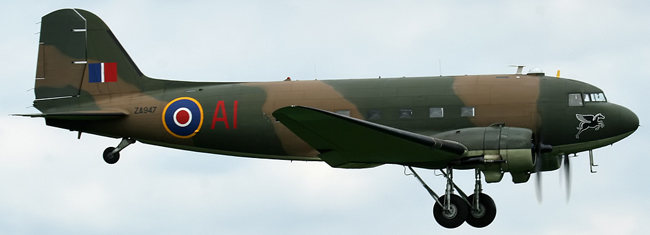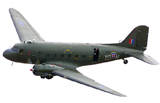Douglas C-47 Dakota

Douglas C-47 Dakota Mk III - ZA947
The C-47 Skytrain was a product of the Douglas Aircraft Company and is regarded as the best transport of World War II. Interestingly enough, the Skytrain was first born as a civilian passenger airliner in the DC-3 model and began operations in the 1930s, setting new levels of performance for any commercial aircraft of the time. The system would become an instrumental component to the American war effort in the Second World War as the C-47 Skytrain platform with its eventual introduction into service by late 1940. From there, the system would continue to serve throughout the war and beyond, seeing service with a variety of nations and in a variety of combat and peace time roles.
With its introduction into war development, the DC-3 was modified from commercial airline to military transport. Chief among the changes were the revising of the passenger cabin to include seating for up to 27 combat-ready personnel. This accommodation was accomplished by the removing of the airliner-style seats and the implementation of utilitarian seating on either side of the cabin in the form of bucket seats. Other notable peacetime to wartime changes included the fitting of Pratt & Whitney radial-piston engines in place of the Wright Cyclones found in the DC-3. The initial production was delivered with the designation of C-47 and the appropriate identifier of Skytrain. No sooner were 93 examples of the base C-47 produced before the line evolved to producing the C-47A, made notable by the improved electrical capacity for onboard systems. One of the more definitive production marks in the series was later born with the C-47B which featured improved performance engines and were earmarked for work in South East Asian theatres. This particular model featured high-altitude capabilities, making it ideal for the required flights to China from the US.
Externally, the C-47 was of a fundamental shape, featuring smooth rolling contours, a low-monoplane wing set, tubular cabin and a single vertical tail surface. Two engines were mounted at each wing leading edge and provided some 1200 horsepower each. The pilot and co-pilot sat at the extreme front of the fuselage with an observation blister directly behind the cockpit. Entry/exit doors were situated at the forward and aft fuselage sides. The aircraft as a whole was duly noted for its ability to withstand extreme amounts of damage and still keep aloft.
During World War II, the armed forces of many countries used the C-47 and modified DC-3s for the transport of troops, cargo and wounded. Over 10,000 aircraft were produced in Long Beach and Santa Monica, California and Oklahoma City, Oklahoma.
The C-47 Skytrain appeared in similar and varied forms with the US Navy (as the R4D), the British Royal Air Force (as "Dakota" marks), the Soviet Air Force (produced by Lisunov as the Li-2 and with Japan as the L2D. In all, over 12,000 examples were produced with the series seeing use up into the 1960s. The Skytrain also earned the affectionate nicknames of "Gooney Bird" and & "Old Bucket" during its heyday. In both civilian travel and military transport, the Skytrain airframe proved to be up to the task making it one of the more influential aircraft designs of all time and undoubtedly contributed immensely to the Allied war effort and its ultimate victory.



The C-47 was vital to the success of many Allied campaigns, in particular those at Guadalcanal and in the jungles of New Guinea and Burma where the C-47 (and its naval version, the R4D) made it possible for Allied troops to counter the mobility of the light-traveling Japanese army. Additionally, C-47s were used to airlift supplies to the embattled American forces during the Battle of Bastogne. But possibly its most influential role in military aviation was flying "The Hump" from India into China. The expertise gained flying "The Hump" would later be used in the Berlin Airlift, in which the C-47 would play a major role, until being replaced by the C-54.
In Europe, the C-47 and a specialized paratroop variant, the C-53 Skytrooper, were used in vast numbers in the later stages of the war, particularly to tow gliders and drop paratroops. In the Pacific, with careful use of the island landing strips of the Pacific Ocean, C-47s were even used for ferrying soldiers serving in the Pacific theatre back to the United States.
C-47s in British and Commonwealth service took the name Dakota, from the acronym "DACoTA" for Douglas Aircraft Company Transport Aircraft. The C-47 also earned the informal nickname Gooney Bird during the European theatre of operations. The C-47 was also used in quantity during the Berlin Airlift of 1948 - 1949.
The USAF Strategic Air Command had C-47 Skytrain's in service from 1946 through 1967. After World War II Douglas structurally modified a number of the early Navy R4D aircraft and the US Navy re-designated the modified aircraft as R4D-8, later C-117D, sometimes referred to as the Super Dakota.
Several C-47 variations were used in the Vietnam War by the United States Air Force, including three advanced electronic warfare variations which were sometimes called "Electric Gooneys" designated EC-47N, EC-47P, or EC-47Qs depending on the engine used. EC-47's were also operated by the Vietnamese, Laotian and Cambodian Air Forces. A gunship variation, utilizing three 7.62mm mini guns, designated AC-47 "Spooky" often nicknamed "Puff the Magic Dragon" was also deployed.
The Royal Canadian Air Force and later, the Canadian Air Force employed the C-47 for transportation, navigation and radar training, and search & rescue operations from the 1940s to the 1980s.
After World War II thousands of surplus C-47s were converted to civil airline use, some remaining in operation in 2009. Today, one is currently being operated by the Battle of Britain Memorial Flight based at RAF Coningsby.
| Model | Production |
|---|---|
| C-47 | 93 built (all for the US Army Air Corp) |
| C-47A | 4,931 built (all for the US Army & Air Force) |
| C-47B | 3,241 built (all for the US Army & Air Force) |
| Lisunov Li-2 | 2,700 built (all for the Russian Air Force) |
| C-53 | 440 built (all for the US Army & Air Force) |
| Dakota Mk.I | 50 built (RAF variant of the C-47) |
| Dakota Mk.II | 90 built (RAF variant of the C-53) |
| Dakota Mk.III | 962 built (RAF variant of the C-47A) |
| Dakota Mk.IV | 896 built (RAF variant of the C-47B) |
| Length: | 63.75ft (19.43m) |
| Width: | 95.51ft (29.11m) |
| Height: | 16.99ft (5.18m) |
| Accommodation: | 3 |
| Hardpoints: | 0 |
| Empty Weight: | 18,199lbs (8,255kg) |
| MTOW: | 25,999lbs (11,793kg) |
| Max Speed: | 230mph (370kmh; 200kts) |
| Max Range: | 1,600miles (2,575km) |
| Rate-of-Climb: | 1,041ft/min (317m/min) |
| Service Ceiling: | 23,999ft (7,315m; 4.5miles) |
| Engine: | 2 x Pratt & Whitney R-1830-92 14-cylinder radial piston engines delivering 1,200hp each |
| Armament Standard: | None |
| Armament Optional: | None |
